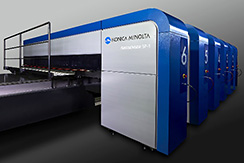News Releases
Nassenger SP-1, an Ultra-High-Speed Inkjet Textile Printer Using a Single Pass System, to be Launched at the End of 2015
- Konica Minolta starting demonstrations in Italy in September, and showcasing the technology at an international exhibition, ITMA 2015, in November -
Tokyo (August 11, 2015) - Konica Minolta, Inc. (Konica Minolta) will launch at the end of 2015 the Nassenger SP-1, a high-productivity, high-resolution inkjet textile printer that employs a single pass system, in response to the increasing use of digital printing in the textile printing industry. Prior to the launch of this new model, Konica Minolta will give demonstrations of Nassenger SP-1 to customers at its sales subsidiary in Italy, starting from September 2015, and then showcase this model’s technology at ITMA 2015, an international textile machinery exhibition held in Milan, Italy in November 2015.
Nassenger SP-1 is characterized by advanced features such as ultra-high speed, high productivity and high resolution, which are made possible by Konica Minolta’s expertise in developing and producing all printheads, printing mechanisms and inks for inkjet textile printers.
Main features
- Nassenger SP-1 employs a single pass system that prints on a fabric (medium) as the fabric is fed under a fixed print unit. This model boasts a much higher print speed than a scan-type printer that prints by moving a printhead carriage back and forth, and thus can meet the needs of the market for a printer with the speed of a screen printing machine.
- The highly precise ink ejection control capability of this model enables high-resolution images to be reproduced at an ultra-high speed.
- The model incorporates newly developed printheads that can eject smaller ink droplets than conventional printers and Konica Minolta’s proprietary ink ejection control technology, which enables the ink droplet size to be adjusted (large, medium, and small), thus achieving higher-quality reproduction of fine patterns and color gradients.
- The model employs the following mechanisms that help to reduce downtime that can directly affect productivity:
- - Konica Minolta’s proprietary image processing technology minimizes the problems of streaking and uneven density on a printed image and reduces defective prints.
- - The modular printhead and the capability of automatic adjustment of ink droplet ejection positions enable far faster exchanging of printheads.
- Reactive dye ink*1 and disperse ink*2 developed specifically for the single pass system can be used. The reactive ink meets the criteria of the Global Organic Textile Standard (GOTS)*3.

Nassenger SP-1
Inkjet textile printer
Background to the development
In the global textile market, there have been increasing demands for low-volume high-mix production, shorter lead time, improved print quality, resource saving and environmental preservation. Against this backdrop, inkjet textile printing is gaining popularity among customers for the unique capabilities of digital printing that can cater to all these demands, namely: (1) on-demand printing, (2) plateless printing, and (3) greater environment friendliness resulting from the reduction of effluent and use of fuels.
While screen printing machines with print speeds of 2000-3000 m2/hour are used for high-volume printing in most cases, users of these machines are now calling for inkjet textile printers with the print speed of screen printing machines. Nassenger SP-1 was developed to meet the needs of these users.
*Demonstration of Nassenger SP-1
Konica Minolta will set up a demonstration room in Konica Minolta IJ Textile Europe, a sales subsidiary established in Como, Milan, the center of the textile printing industry in Europe, to give demonstrations of Nassenger SP-1 for prospective customers starting from September 2015.
*ITMA 2015
ITMA is the largest textile machinery exhibition in the world, held every four years. ITMA 2015 will be held from November 12 to 19 in Fiera Milan (Rho), where Konica Minolta will showcase the technology of Nassenger SP-1 at its booth C108 in Hall 18.
With its brand proposition “Giving Shape to Ideas,” Konica Minolta remains committed to innovations in the manufacturing process in the textile printing market, and to helping customers enhance their corporate value, while joining the global effort to reduce environmental threats.
*1: This ink is most suitable for fabrics made of plant fibers such as cotton and rayon.
*2: This ink is most suitable for fabrics made of artificial fibers such as polyester.
*3: GOTS is a global standard for textiles made from organic fibers, and regulates the chemicals used throughout the production process from raw cotton to finished products. The GOTS certification is given to products and dyes that meet comprehensive criteria, both environmental and social, set by GOTS.
